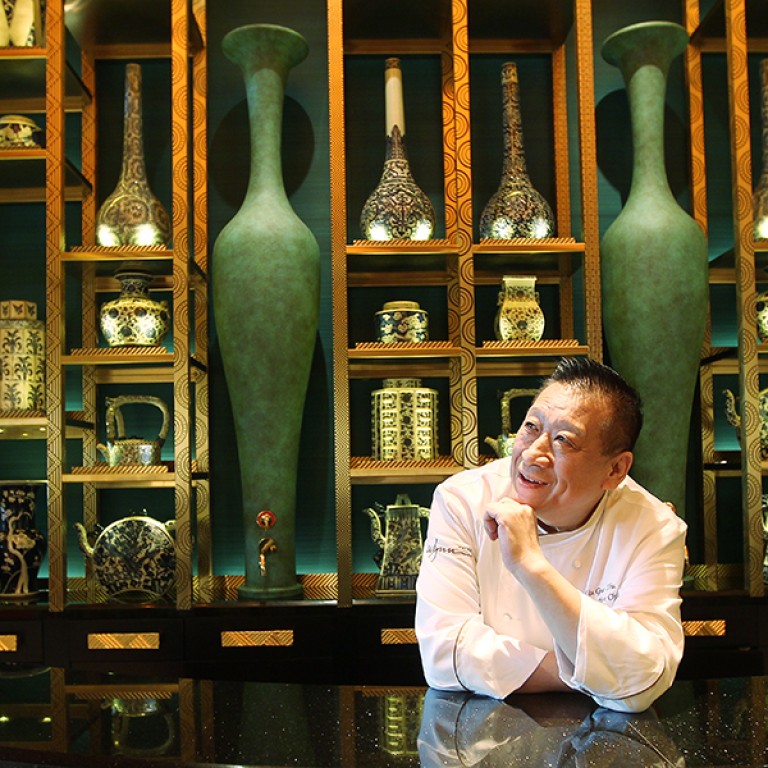
Time for a Tan
Liu Guozhu's lifetime of experience includes the little-known art of a special cuisine, writes Bernice Chan
Although Liu Guozhu was inspired to become a chef like his father and uncle before him, the executive chef of Golden Flower really learned how to cook from the age of 16, when he was chosen as one of 15 apprentices in the kitchens of the Beijing Hotel.
"At the time, the hotel restaurant only served high officials and foreign dignitaries," Liu, 65, recalls. "Ordinary people were not allowed inside the hotel, so we knew we had an important job to do."
He remembers spending the first six months only doing simple jobs, such as cleaning vegetables that came straight from farms, and then beginning to learn how to cook.
Liu spent more than two decades at the Beijing Hotel, on the corner of Wangfujing Street and Chang'an Avenue. He has fond memories of his early years there, as the nearby Great Hall of the People did not have a proper kitchen, making the hotel responsible for all the catering during large events.
"We had to prepare food three days in advance. There was so much to do, we didn't go home - we just slept where we could find a spot. All we thought about was what tasks we had to do," he recalls.

It was created by Cantonese Qing dynasty official Tan Zongjun, who lived in Beijing and discovered Lu, or Shandong, cuisine. Because of his love of gastronomy, Tan developed a cuisine that combined the best of China's north and south, and later the spicy addition of Sichuan flavours.
The most important element in this unique cuisine is the chicken stock, which is used in soups and in thicker sauces for braised fish maw and abalone. Liu explains that the stock is made fresh every day, and all the ingredients - including an aged hen, aged duck and lean pork, along with Jinhua ham and conpoy - must be fresh, and they are simmered together for seven to eight hours.
Excess oil is periodically removed, and through a number of tedious steps, the stock is made clear. Part of this is reserved for clear soups, such as the delicate fresh clam and jasmine in chicken soup, and the steamed fish with chicken stock "Tan style" topped with layers of mushrooms, bamboo shoots and dried shrimp that are on Golden Flower's menu.
Liu later moved to the new Beijing Grand Hotel to helm the entire culinary operation. He worked there for 14 years, then moved to Hong Kong, where he was chief instructor of Chinese cuisine at the Chinese Culinary Institute of Hong Kong.
He was persuaded out of retirement to open Golden Flower in 2008, which was awarded its first Michelin star last year and two this year, and he also oversees all the Chinese culinary operations of the Wynn Macau.
Liu says Tan cuisine is different from other Chinese styles because it is very delicate and detailed. "It is family-style, in that you can make these dishes at home. The ingredients must be fresh and in small portions."
One hearty dish is the stewed turtle skirt with garlic and starch noodles served with pancakes. The sauce is rich in taste but hardly heavy, and the noodles and diamond-shaped pancakes soak it up.

Although not many chefs know how to prepare Tan cuisine, Liu is confident it will continue to flourish. "You cannot teach it in a classroom setting," he explains. "It must be one-on-one, master and apprentice. That way, the student gains hands-on experience and learns from previous mistakes, and gets to know more about the philosophy of Tan cuisine." He says he has a number of apprentices well-versed in Tan cuisine, not only in China but in the United States as well.
"They might be cooking other cuisines at the moment, but when they have to prepare Tan cuisine, they have the skills and knowledge," Liu says. "It is a cuisine that has more than 200 years of history. Authentic Tan cuisine can be expensive to prepare, so it makes it exorbitant. But there are some chefs who may not use such premium ingredients but have the same style and spirit."
Liu adds that the cuisine is quite limited in its number of dishes, and unlike Cantonese cuisine does not have dim sum.
Nevertheless, he is confident that Tan cuisine will develop further, as long as the traditional cooking techniques continue to be handed down like they were to him.

